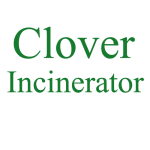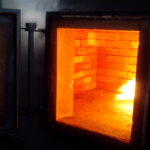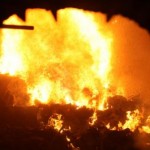Nanjing Clover Medical Technology Co., Ltd. is a leading waste incinerator manufacturer in China. All series included burning capacity 10kgs per hour, 30kgs per hour,50kgs per hour,100kgs per hour,150kgs per hour,300kgs per hour,500kgs per hour. Up to now, all models sale to all over the world and have good feedback from end-customer. The YD Model medical incinerator have multi-combustion chamber and basic dry scrubber (smoke filter chamber) with reasonable project budget. For the cleaner emission require, we accept custom made wet scrubber for incinerator and this will be also our next working by focusing on emission technical.
Regular model incinerator for market with burning rate from 10kgs to 500kgs per hour and we always proposal customer send us their require details, like waste material, local site fuel and power supply, incinerator operation time, etc, so we can proposal right model or custom made with different structure or dimensions.
Incinerator Model YD-100 is a middle scale incineration machine for many different usage: for a middle hospital sickbed below 500 units, for all small or big size family pets (like Alaskan Malamute Dog), for community Municipal Solid Waste Incineration, etc. The primary combustion chamber volume is 1200Liters (1.2m3) and use diesel oil or natural gas fuel burner original from Italy.
All our incinerator use stainless steel chimney, not steel.All our incinerator have two combustion chamber at least, not single chamber. All fuel burner from Italy made with famous brand, best quality.
300kgs per hour burning rate incinerator is well liked by market because this model can be medical waste incineration equipment for big hospital and also very good for other solid waste treatment with lowest cost, even if big size animals also can be feed into the combustion chamber. The primary combustion chamber volume is 2.4m3, big enough for common size animals. For shipping transport, YD-300 can be loaded into 40’feet full high container.
Big size combustion chamber up to 4.0m3 and Internal Dimensions is 257 x 147 x 108cm with feeding door opening 108 x 128cm. This model can be a small waste incineration factory with little amount of budget funds. If end customer use this for farm to burn animals like cow, horse or camel, contact with us now.
Author Archives: animal-incinerator
Smart Ash Incinerators
Smart Ash Incinerators
1. Size requirement for the incinerators is that the unit works with a 55 gallon open ended
steel drum.
2. The unit should operate wit. no fuel and use only 120V or 220V electricity for the blowers.
3. The unit should be capable of burning oil contaminated wastes and medical wastes with a moisture content of 0-15%J
4. Each unit should come witH two steel drums, so that a spare drum is available.
Spare Parts Option
If there are any vendor suggested spare parts , that list and price should be included as an option in the offer.
INDUSTRIAL INCINERATORS
Large incinerators – INDUSTRIAL INCINERATORS – specs below.
2.) Size requirement for the incinerators is 750 — 850 kg capacity
3.) The bum rate should be 80 LL 100 kg/ hour.
4) The primary chamber shouId have an operating temperature of 900 -1200 degree C.
5) The incinerator should hate a high temperature secondary chamber and 2 second gas
retention time at 850- 1150 degree C so that it is suitable for high risk materials.
6). The incinerator should have temperature monitoring and thermostat control for ease of
operation and assurance of bum temperature to confirm correct operation.
7). The incinerator should be capable of burning any of the hazardous wastes listed in the
subsequent section.
8) The incinerator should be capable of burning diesel oil and should include a larger fuel
tank (10-500 litres) and generator (3 –40 kV) set that can be carried on the trailer with the
incinerator so that the unit requires no external electrical power supply.
9.) The incinerator should be trailer mounted so that it is a po
Hazardous Waste to be Incinerated
Hazardous solid chemical:
Different types of combustible solids, used textiles, grease, and toner cartridges, chemicals
for water purification and photographic consumables and plastic material, empty
plastic/metal cans that still contain remnant hazardous material, oil absorbent.
Hazardous liquid chemical:
Mainly different types. of Acid, Paint, Varnish, Acetone, White Spirit Aromatic-less
Solvents, Synthetic Liquid for Break Systems, Aircraft De-icing Liquid, Hydraulic and
Compressor oil, Freon, used in some older refrigeration units, Insecticide liquid/spray, air
refresh spray and other similar chemicals.
Contaminated fuel:
Mainly diesel or gasoline contaminated by water or solvents.
Used and/or Contaminated oil:
Used motor oils and/or mineral oils unfit for their originally intended use. Mainly motor
and gearbox oil (approximately 80%) contaminated by a mixture of white spirit and acetone (approximately 51%), hydraulic liquid (approximately 5%).
Contaminated water:
Waste oilshvater, leaches, hydrocarbons/water mixtures, emulsions and leachate.
Contaminated soil:
Soil polluted by oil, fuel or 11 chemicals.
Contaminated soil polluted by chemicals that has to be recycled in landfill.
Contaminated soil—treated and replaced on site.
Oil Contaminated Solids
Rags, Absorbents, Cardboard, oil and fuel filters, air filters are not consider as hazardous materials.
Electronic waste:
Waste electrical or electronic appliances or assemblies, including printed circuit boards,
containing toxic material and/or heavy metal and/or emitting low radiation.
Used battery cells:
Dry battery, UPS battery or other types, unsorted waste batteries/ battery cells, containing
materials that are hazardouy.
Used lead-acid batteries:
Waste lead-acid batteries, rained/un-drained, and whole or crushed.
Hazardous medical waste:
Clinical and related waste, arising from medical, nursing or similar practices and waste
generated in clinics during the investigation or treatment of patients (bio hazard).
Expired drugs, solid:
Waste pharmaceuticals, drugs and medicines, including sensitive medicines.
Expired drugs Iiquid:
Waste liquid pharmaceuticals, different type liquid chemicals for treatment, medical
grease, and paraffin based xpired medicines.
Expired and/or contaminated fod:
Spoiled fresh food or unusable MRE’s (Meal Ready for Eat – dry food)
Onsite Training and Assem Option for Industrial Incinerators
I. The bidders should includ 1a price in their offer for training in a central location ( Goma or
Bukavu) approximately 15 staff in the operation and maintenance of the
equipment.
Incinerator Introduction
Principle of the Incinerator equipment is incineration/combustion/burn. Generally, the function is waste treatment for Solid waste, Liquid waste, Gas waste, etc.
The main body is one combustion chamber (at least), Refractory line or firebrick, Insulation materials and the outer plate. Ignition element is external oil or gas burner. The burner can be running until waste burnout but for some waste like plastic, paper (sometime, mix coal with waste before feeding), they can combustion itself after Ignition. During combustion, burner has a fan itself for Oxygen supply and also protect burner avoid heat damage from combustion chamber. And, there a external fan blow air into combustion chamber. The Exhaust gas blow out after combustion.
Considering Environmental Protection requirements and rules, almost all incinerator have secondary combustion chamber (after-burn, post-combustion), even if third combustion chamber. The secondary burner burn the Exhaust gas from primary combustion chamber, this technology make sure sufficient combustion, few black smoke and smell.
The updated incinerator technology focus on Exhaust gas treatment to remove Hazardous material and other function from incinerator, like heat recovery (waste to energy), save fuel cost, PLC Automation operation.
In some Developed countries, some new waste treatment method like High-temperature cooking, waste carbonization, crushing sterilization technology is instead of incineration technology.
incinerators plants
In the process of developing a project, we came across an issue, which is the estimate cost of incinerators plants (capable to destroy chlorinated in an environmental friendly way – please provide cost estimate/price range of incinerator plant).
- What kind of waste is to be burned?
- In which country the incinerators have to be installed?
- What about the amount of waste to be burnt per hour/day/week or per cycle?
- Ozone depleting Substances (chlorinated gas, CFC-11/12, HCFC-22 and similar mixtures), POPs (Polychlorierte Biphenyle mainly). Temperature of over 1200C is required.
- 150 MT of POPs (PCB) 210 MT of ODS for 3 countries in 2 years. Therefore it would be good to know the connection between price and capacity. (starting from 1 t/day for X USD till 10.000 t/day for XXXXUSD)
SHARP MEDICAL WASTES
A SET OF INCINERATOR FOR DISPOSAL OF SUCH HOSPITAL SHARP WASTES LIKE THE NEEDLES,SYRINGES,CUTTERS, BLADES, ETC.
WASTE BUCKET/TANK – ABOUT 2000KG
CAPACITY OF FEEDING: ABOUT 600-800Kg AT A TIME.
BURNING AT ABOUT 150/165-200 IN 60MINS
THE BURNER SHALL USE DIESEL/OIL
WITH CHIMNEY, ELECTRIC PANNELS,ELECTRIC MOTORS,ETC.
MATERIALS FOR DISPOSAL: SHARP MEDICAL WASTES.
Mixed Biomedical waste Incinerator
Product :Mixed Biomedical waste Incinerator
Quantity :60 units
Contract period:To be decided by the supplier
Please confirm your willingness to execute this contract project by sending brochure and your price quotation for the below specification to enable us submit it to the firm incharge of the contract for their study and approval.
Type of Waste: Mixed Biomedical waste.
1. Waste burning capacity of unit: 100-125 kgs / hr.
2. Mode of waste handling : Autoloading– DFDV + Bucket elevator
3. Type of fuel : LDO / HSD
4. Type of Burner operation : Automatic
5. Expected fuel consumption: 30-35 kgs/hr **(depending upon overall
mix of the waste, moisture
content, etc.) after preheat.
6. Connected electrical load : Approx. 7-8 KW (AC 3 phase,220V, 50 Hz).
7. Overall space requirement : 9 m (L) X 8 m (W) X 6 m (H) Each unit
without stack
Burners temperature controlled (TIC – Thermocouple) and work on ON –
OFF basis. The frequency on ON – OFF will depend upon the nature of
waste, moisture content, calorific value, etc. and shall vary from waste to
waste. The fuel consumption also depends upon the frequency of the door
opening and method of operation of the incinerator. We have mentioned
approx. expected fuel consumption figures.
The Incineration System comprises of :
I. Main Incinerator with
A. Primary & Secondary Chamber Modules duly refractory lined, piped & wired.
B. Bucket elevator + DFDV mechanism for autoloading and Deashing
mechanism
II i. 1 No. fully automatic Fuel Oil burner for primary chamber.
ii. 1 No. fully automatic Fuel Oil burner for secondary chamber.
III. Centrifugal forced draft fan assembly complete with motor drive, duct and
dampers, etc. mounted on the common skid of the unit to provide :
Combustion air.
Eductor air.
IV. Eductor Assembly for :
Cooling of exhaust gases from 900 – 1000 0 C to around 350 0 C .
Keeping the entire system under negative pressure to avoid hot gases / dust
particles rushing out of charging door.
V. Electrical Control Panel along with safeties, and Audio / Visual
indicators and
/ or alarms for efficient and safe operation of the system.
VI. Electrical wiring of the unit.
VII. Oil tank of 1000 ltrs capacity mounted on the skid
VIII. Operating tools and tackles comprising of – rake, hoe, shovel (I No. each).
IX. Chimney of 2.5 Mtr height.
WASTE INCINERATOR
INCINERATOR (WASTE INCINERATOR)
Designed to burn disposables that can and should be destroyed on-site. Theses wastes include infectious and contaminated “red bag.” Surgical dressings, plastic test devices and other wastes
Fast, complete, efficient waste disposal
Dual chamber combustion, Chambers insulated and lined with high temperature refractory. Programmable digital temperature controls, temperature indicators and charge recorder. Modulating control for fuel and air lowers fuel consumption.
Minimum installation and start up time
Aluminized steel jacket lined with refractory and firebrick. Monitors recorders and other accessory equipment should be available.
Charging system:
- Vertical charge door on primary chamber.
- Pneumatic or hydraulic ram charging system.
- Auto shut down of the door after charging.
- Primary and secondary chamber temperature displayed and recorded (optional)
Charging rate:
- Up to 100kgs per hour of waste or red bag waste rated at 2200 BTU’s per kg.
Fuel:- Natural Gas
Capacity (Cubic Mtr): 1.65M3 or more
Ave Capacity: 100kg per hour
Secondary Chamber Capacity (CubicMtr) :3.88 or more
Length (mm): 1880 or better
Width (mm): 1280 or better
Height Incl. Flue (mm): 7700 or better
Ash Door Opening (mm): 475×900 or better
Min. Operating temperature: 90 degree centigrade
Max, Operating Temperature: 1350 degree centigrade
Residency time in Second Chamber: 2 sec
Temperature Monitoring: Both for primary and secondary chambers.
Loading SystemManual/semi-automatic
Waste destruction efficiency:> 90% by weight
Filter: Ceramic or other equivalent filters in order to reduce the induction of hazardous air pollutants, particulates, co,dioxin/furane into the atmosphere.
De ashing system: Manual/semi-automatic.
The System must be quoted complete with:-
- Plumbing
- Electrical panels
- Civil works
- Waste collection Trolleys
Finish/ Paint:-
High Quality heat resistant, two layers high-grade epoxy Paint coating.
Installed Power (Electric Voltage): 440V/ 50 Hz
Waste Management Equipment must have ;
Mobile loading trolley: 06 No’s – For transportation of hospital waste from wards to incinerator site/ room, Opening from the top.
WASTE BINS MOBILE: 06 No’s-Made of Plastic, in blue color with a cover flap.
Plastic Bags: 2000 no’s each in Red and Yellow color.
Heavy Duty Gloves Pairs: For Waste handling staff-06 Pairs
Long Shoes Pairs: For waste handling – 06 Pairs.
Make: UK, Europe, USA, Japan



